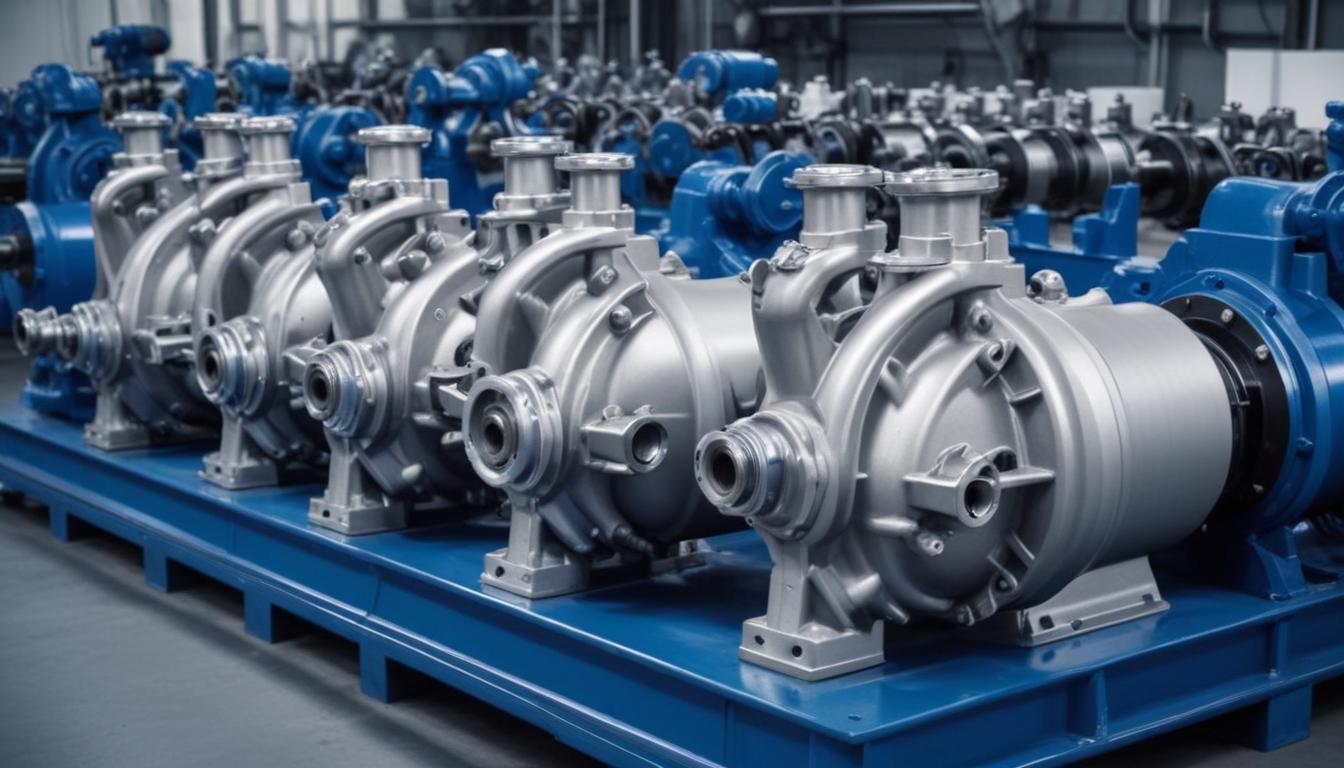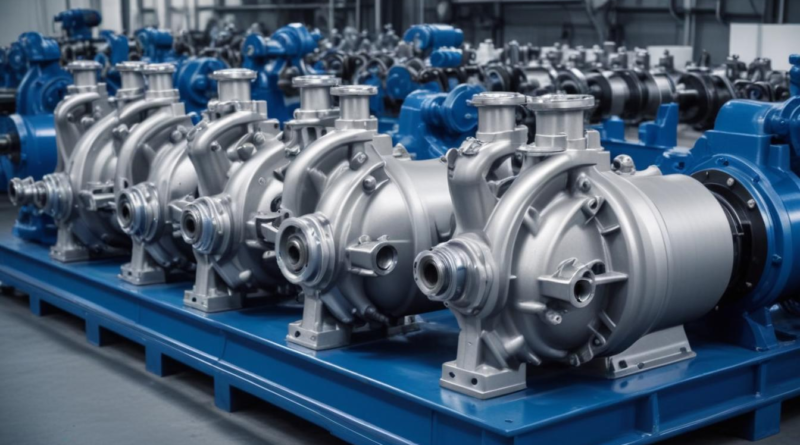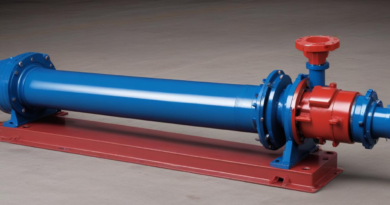pumps in the automotive industry
Automotive pumps play a crucial role in the functionality and efficiency of modern vehicles. Understanding the various types of pumps is essential for diagnosing issues and optimizing performance. Here are the primary categories of automotive pumps:
- Fuel Pumps: Responsible for delivering fuel from the tank to the engine. They ensure the engine receives the correct amount of fuel for combustion.
- Water Pumps: Circulate coolant through the engine and radiator to maintain optimal operating temperatures, preventing overheating.
- Oil Pumps: Supply lubricating oil to the engine’s moving parts, reducing friction and preventing wear.
- Power Steering Pumps: Provide hydraulic pressure to assist in steering, making it easier to turn the vehicle’s wheels.
- Air Conditioning Pumps: Facilitate the circulation of refrigerant through the HVAC system, ensuring effective cooling of the vehicle’s interior.
| Type of Pump | Primary Function | Common Applications |
|---|---|---|
| Fuel Pump | Delivers fuel to the engine | Gasoline and diesel engines |
| Water Pump | Circulates coolant | Engine cooling systems |
| Oil Pump | Supplies lubricating oil | Engine lubrication |
| Power Steering Pump | Provides hydraulic pressure | Steering systems |
| Air Conditioning Pump | Circulates refrigerant | HVAC systems |
Each type of automotive pump is designed to perform specific applications within the vehicle, ensuring smooth and reliable operation. Advances in pump technology continue to enhance performance, efficiency, and durability across all these critical systems.
applications in vehicles
Automotive pumps are integral to a wide range of vehicle systems, each serving specific functions that ensure optimal performance and reliability. The fuel pump is pivotal in maintaining the necessary fuel pressure for engine combustion, especially in modern fuel-injected engines where precise fuel delivery is crucial. By consistently supplying fuel from the tank to the engine, it supports efficient combustion and overall engine performance.
The water pump plays a vital role in the vehicle’s cooling system. It circulates coolant through the engine and radiator, maintaining the engine at optimal temperatures and preventing overheating. This circulation is essential not only for engine performance but also for the longevity of engine components, as excessive heat can lead to significant wear and damage.
Oil pumps are responsible for delivering lubricating oil to various engine parts. This lubrication reduces friction between moving components, minimizes wear and tear, and helps in dissipating heat generated during engine operation. Effective lubrication is fundamental to maintaining engine efficiency and extending its lifespan.
In the realm of steering and maneuverability, the power steering pump provides hydraulic pressure that assists in turning the vehicle’s wheels. This assistance makes steering smoother and requires less physical effort from the driver, enhancing driving comfort and control, particularly at low speeds or when parking.
The air conditioning pump is essential for the vehicle’s HVAC (heating, ventilation, and air conditioning) system. It circulates refrigerant through the system, facilitating effective cooling of the vehicle’s interior. Efficient operation of the air conditioning pump ensures a comfortable cabin environment, which is especially important in extreme weather conditions.
Advanced automotive systems leverage specialized pumps to meet evolving performance and efficiency standards:
- Electric Power Steering Pumps: Employed in electric power steering systems, these pumps are electronically controlled to provide variable assistance based on driving conditions, improving fuel efficiency and steering precision.
- Battery Cooling Pumps: Found in hybrid and electric vehicles, these pumps manage the temperature of high-capacity batteries, ensuring optimal performance and longevity.
- Turbocharger Fuel Pumps: Designed to deliver higher fuel pressures required during turbocharged engine operation, enhancing power output and efficiency.
| System | Pump Type | Application |
|---|---|---|
| Engine Combustion | Fuel Pump | Delivers fuel to the engine for combustion |
| Engine Cooling | Water Pump | Circulates coolant to maintain engine temperature |
| Engine Lubrication | Oil Pump | Supplies lubricating oil to engine components |
| Steering Assistance | Power Steering Pump | Provides hydraulic pressure for easier steering |
| HVAC System | Air Conditioning Pump | Circulates refrigerant for cabin cooling |
| Electric Steering | Electric Power Steering Pump | Electronically controls steering assistance |
| Battery Management | Battery Cooling Pump | Maintains optimal battery temperatures in EVs |
| Turbocharged Engines | Turbocharger Fuel Pump | Delivers high-pressure fuel for turbo operation |
These diverse applications of automotive pumps illustrate their essential role in ensuring the seamless operation of various vehicle systems. By efficiently managing fuel delivery, engine cooling, lubrication, steering, and climate control, automotive pumps contribute significantly to the overall performance, safety, and comfort of modern vehicles.
technological advancements
Advancements in pump technology have significantly enhanced the performance, efficiency, and reliability of automotive systems. Modern automotive pumps incorporate cutting-edge materials, intelligent control systems, and innovative designs to meet the evolving demands of contemporary vehicles.
Electric and Hybrid Vehicles have driven the development of specialized pump technologies. For instance, electric water pumps eliminate the need for mechanical drives, allowing for more precise control of coolant flow and improved energy efficiency. Similarly, electric power steering pumps offer variable assistance, adjusting the level of steering support based on the vehicle’s speed and driving conditions, thereby enhancing both performance and fuel economy.
Smart Control Systems integrate advanced electronics and sensors to optimize pump operation. These systems enable real-time monitoring and adjustments, ensuring pumps operate at optimal efficiency under varying conditions. For example, smart fuel pumps can adjust the fuel delivery rate dynamically based on engine load and speed, reducing fuel consumption and emissions.
Material Innovations have also played a crucial role in advancing pump technology. The use of lightweight and durable materials, such as advanced polymers and composites, has reduced the overall weight of pumps, contributing to improved vehicle efficiency. Additionally, corrosion-resistant materials extend the lifespan of pumps, reducing maintenance requirements and enhancing reliability.
Energy Efficiency Enhancements are achieved through improvements in pump design and operation. High-efficiency impellers and optimized flow pathways minimize energy losses, ensuring that pumps deliver the necessary performance with minimal power consumption. Variable speed drives and regenerative technologies further enhance energy efficiency by adapting pump operation to real-time demand.
Integration with Vehicle Networks allows pumps to communicate with other vehicle systems, enabling coordinated operation and improved overall system performance. For example, integration with the engine control unit (ECU) allows the coolant pump to synchronize with engine cycles, optimizing cooling performance and reducing energy usage. Similarly, integration with the vehicle’s HVAC system ensures precise control of climate conditions within the cabin.
Innovations in 3D Printing and additive manufacturing have revolutionized pump design and production. These technologies enable the creation of complex geometries and bespoke components that were previously difficult or impossible to manufacture. As a result, pumps can be tailored to specific applications, enhancing performance and adaptability in various automotive systems.
| Technological Advancement | Description | Impact on Automotive Pumps |
|---|---|---|
| Electric Pump Systems | Utilization of electric motors for pump operation | Increased control precision and energy efficiency |
| Smart Control Integration | Incorporation of sensors and electronics for real-time monitoring | Optimized performance and reduced emissions |
| Advanced Materials | Use of lightweight and corrosion-resistant materials | Enhanced durability and reduced weight |
| High-Efficiency Designs | Optimized impellers and flow pathways | Lower energy consumption and improved performance |
| 3D Printing | Additive manufacturing for complex pump components | Customized designs and rapid prototyping |
Hybrid and Plug-in Hybrid Systems present unique challenges and opportunities for pump technology. These vehicles require precise management of multiple power sources, necessitating pumps that can seamlessly switch between electric and mechanical operation. Innovations in hybrid pumps ensure smooth transitions and reliable performance across different driving modes.
Regenerative Technologies are being integrated into pump systems to recover and reuse energy. For example, regenerative braking systems can capture kinetic energy and use it to power certain pump operations, enhancing overall vehicle efficiency and reducing the load on the engine.
Noise Reduction Techniques have become a key focus in pump design, particularly for electric pumps that operate continuously. Advanced damping materials, optimized pump housing designs, and precise manufacturing tolerances work together to minimize operational noise, contributing to a quieter and more comfortable driving experience.
- Thermal Management: Enhanced cooling strategies ensure pumps operate within optimal temperature ranges, preventing overheating and extending component life.
- Modular Designs: Modular pump systems allow for easier upgrades and replacements, providing flexibility in vehicle design and maintenance.
- Predictive Maintenance: Advanced diagnostics and machine learning algorithms predict pump failures before they occur, enabling proactive maintenance and reducing downtime.
The continuous evolution of pump technology in the automotive industry reflects the broader trends towards greater efficiency, sustainability, and integration of intelligent systems. These technological advancements not only improve the performance and reliability of automotive pumps but also contribute to the overall advancement of vehicle engineering and design.
maintenance and troubleshooting
 Regular maintenance is essential to ensure the longevity and optimal performance of automotive pumps. Each type of pump requires specific maintenance procedures to prevent failures and maintain efficiency. Implementing a comprehensive maintenance schedule can help identify potential issues before they escalate, reducing downtime and costly repairs.
Regular maintenance is essential to ensure the longevity and optimal performance of automotive pumps. Each type of pump requires specific maintenance procedures to prevent failures and maintain efficiency. Implementing a comprehensive maintenance schedule can help identify potential issues before they escalate, reducing downtime and costly repairs.
- Fuel Pumps:
- Inspect fuel lines for leaks or damage regularly.
- Replace fuel filters according to the manufacturer’s recommendations to prevent clogging.
- Listen for unusual noises during operation, which may indicate wear or internal damage.
- Check electrical connections and ensure the pump receives the correct voltage.
- Water Pumps:
- Monitor coolant levels and inspect for leaks around the pump gasket.
- Check the drive belt for signs of wear or tension issues.
- Examine the impeller for debris or damage that could impede coolant flow.
- Ensure proper alignment of the pump with the engine to prevent undue stress.
- Oil Pumps:
- Regularly check oil levels and quality to ensure proper lubrication.
- Inspect the oil pump for any signs of oil contamination or leaks.
- Listen for unusual noises such as whining or grinding, which may indicate pump wear.
- Ensure that the oil pressure is within the manufacturer’s specified range.
- Power Steering Pumps:
- Check the power steering fluid level and top up if necessary.
- Inspect hoses and connections for leaks or cracks.
- Listen for whining or groaning noises when turning the steering wheel.
- Ensure the pump belt is properly tensioned and free of damage.
- Air Conditioning Pumps:
- Monitor refrigerant levels and inspect for leaks in the system.
- Check the pump for unusual noises or vibrations during operation.
- Inspect electrical connections and fuses related to the A/C pump.
- Ensure the pump is free from obstructions and can circulate refrigerant smoothly.
Common issues and their symptoms can vary depending on the pump type. The following table outlines typical problems and corresponding indicators:
| Pump Type | Common Issue | Symptoms | Possible Solutions |
|---|---|---|---|
| Fuel Pump | Clogged Fuel Filter | Engine sputtering, difficulty starting | Replace the fuel filter; inspect fuel lines for blockages |
| Water Pump | Coolant Leaks | Overheating engine, visible coolant under vehicle | Replace the pump gasket or the entire pump if damaged |
| Oil Pump | Insufficient Oil Pressure | Engine knocking sounds, warning lights illuminated | Inspect and replace the oil pump; check for oil blockages |
| Power Steering Pump | Noise During Steering | Whining or groaning sounds when turning the wheel | Inspect and replace the pump; check fluid levels and hoses |
| Air Conditioning Pump | Reduced A/C Performance | Warm air from vents, weak refrigerant circulation | Recharge refrigerant; inspect and replace the pump if necessary |
Effective troubleshooting involves a systematic approach to diagnose and resolve pump-related issues. The following steps can aid in identifying and addressing problems:
- Identify the Symptoms: Determine the specific issues, such as unusual noises, leaks, or performance drops.
- Inspect Related Components: Check hoses, belts, and electrical connections for signs of wear or damage.
- Test Pump Operation: Use diagnostic tools like multimeters or pressure gauges to assess pump functionality.
- Refer to Technical Manuals: Consult manufacturer guidelines for specific troubleshooting procedures and specifications.
- Replace or Repair: Based on the diagnosis, perform necessary repairs or replace faulty pump components.
- Verify Functionality: After repairs, ensure the pump operates correctly and that the original symptoms are resolved.
Implementing a proactive maintenance strategy can significantly reduce the likelihood of pump failures. Key best practices include:
- Regular Inspections: Schedule routine checks to identify and address potential issues early.
- Timely Fluid Changes: Replace fluids such as fuel, coolant, oil, and refrigerant according to maintenance schedules.
- Filter Maintenance: Ensure that all filters are clean and replaced as needed to prevent blockages.
- Monitor Performance: Use onboard diagnostics and monitoring systems to track pump performance and detect anomalies.
- Keep Components Clean: Maintain a clean environment around pump components to prevent contamination and wear.
By adhering to these maintenance and troubleshooting practices, vehicle owners and technicians can ensure that automotive pumps remain reliable and efficient, thereby supporting the overall performance and safety of the vehicle.
future trends and innovations
The automotive industry is rapidly evolving, and the future of automotive pumps is poised to reflect these advancements through innovative technologies and enhanced functionalities. Emerging trends focus on increasing efficiency, integrating smart technologies, and adapting to the growing prevalence of electric and autonomous vehicles. These developments aim to optimize pump performance, reduce energy consumption, and extend the longevity of vehicle systems.
Electrification of Pump Systems is a significant trend driven by the shift towards electric and hybrid vehicles. Traditional mechanically driven pumps are being replaced with electrically powered counterparts, offering greater control and flexibility. Electric pumps can be precisely managed by the vehicle’s electronic control units (ECUs), allowing for optimized performance based on real-time demand. This transition not only improves energy efficiency but also reduces the overall weight of the vehicle by eliminating the need for bulky mechanical drive components.
Smart and Connected Pumps are becoming increasingly prevalent as vehicles incorporate more advanced electronics and connectivity features. These pumps are equipped with sensors and integrated with vehicle networks, enabling real-time monitoring and data analysis. By leveraging Internet of Things (IoT) technologies, smart pumps can communicate their status, predict potential failures, and adjust their operations to enhance performance and reliability. This integration facilitates predictive maintenance, reducing the likelihood of unexpected pump failures and extending the service life of automotive components.
Advanced Materials and Manufacturing Techniques are playing a crucial role in the future of automotive pumps. The use of lightweight, corrosion-resistant materials such as advanced polymers and composites enhances the durability and efficiency of pumps. Additionally, advancements in additive manufacturing or 3D printing allow for the creation of complex geometries that improve flow dynamics and reduce energy losses. These material innovations contribute to making pumps more robust and efficient while enabling customized designs tailored to specific vehicle applications.
Energy Efficiency Improvements continue to be a primary focus in pump technology. Future pumps are being designed with optimized impellers and flow pathways to minimize energy consumption while maintaining high performance. Innovations such as variable speed drives allow pumps to operate at different speeds based on demand, further enhancing energy savings. Additionally, regenerative technologies are being explored to recover and reuse energy, contributing to overall vehicle efficiency.
Integration with Autonomous Systems is another emerging trend, as autonomous vehicles require highly reliable and efficient pump systems to manage various functions seamlessly. Pumps in these vehicles must operate with minimal noise and vibration to ensure passenger comfort and system reliability. Advanced control algorithms and precise actuator mechanisms are being developed to meet the stringent requirements of autonomous driving technologies.
Environmental Sustainability is driving the development of eco-friendly pump technologies. Future automotive pumps are being designed to reduce emissions and minimize the environmental footprint of vehicles. This includes the development of pumps that work efficiently with alternative fuels and refrigerants, as well as those that incorporate recycling and energy recovery systems to enhance overall sustainability.
Innovative Cooling Solutions are essential as vehicles, particularly electric and high-performance models, generate significant heat that must be effectively managed. Future pump designs incorporate advanced thermal management systems that ensure optimal operating temperatures for both the pumps themselves and other vehicle components. These solutions often involve sophisticated coolant circulation patterns and the use of high-efficiency heat exchangers.
Table: Future Trends in Automotive Pumps
| Trend | Description | Impact on Automotive Pumps |
|---|---|---|
| Electrification | Transition from mechanical to electric pump systems | Enhanced control, reduced weight, improved energy efficiency |
| Smart Connectivity | Integration with IoT and vehicle networks for real-time monitoring | Predictive maintenance, optimized performance, increased reliability |
| Advanced Materials | Use of lightweight and corrosion-resistant materials | Increased durability, reduced weight, enhanced efficiency |
| Energy Efficiency | Design optimizations and variable speed drives | Lower energy consumption, improved performance |
| Autonomous Integration | Compatibility with autonomous vehicle systems | Reliable operation, minimal noise and vibration |
| Sustainability | Eco-friendly pump technologies and alternative fuels | Reduced emissions, enhanced environmental footprint |
| Innovative Cooling | Advanced thermal management systems | Optimal operating temperatures, improved component longevity |
Collaborative Research and Development efforts between automotive manufacturers and pump technology companies are accelerating the innovation cycle. Collaborative initiatives focus on developing standardized interfaces, shared platforms, and interoperable technologies that can be widely adopted across different vehicle models and brands. This cooperation ensures that advancements in pump technology can be efficiently integrated into new vehicle designs, fostering a more cohesive and innovative automotive ecosystem.
Customization and Modularity are also becoming more prominent, allowing for pumps to be easily adapted to various vehicle types and performance requirements. Modular pump systems can be quickly reconfigured or upgraded to meet the specific needs of different applications, providing manufacturers with greater flexibility in vehicle design and enhancing the ability to respond to market demands swiftly.
Artificial Intelligence and Machine Learning are set to revolutionize pump operation and maintenance. AI-driven algorithms can analyze vast amounts of data from pump sensors to identify patterns, predict potential issues, and optimize pump performance dynamically. This intelligent approach not only enhances the efficiency and reliability of automotive pumps but also contributes to the overall advancement of smart vehicle technologies.
As the automotive industry continues to embrace innovation, the future of automotive pumps will be defined by their ability to adapt to new technologies, meet stringent performance standards, and contribute to the sustainable and efficient operation of next-generation vehicles. These advancements will play a pivotal role in shaping the future landscape of automotive engineering and mobility solutions.




